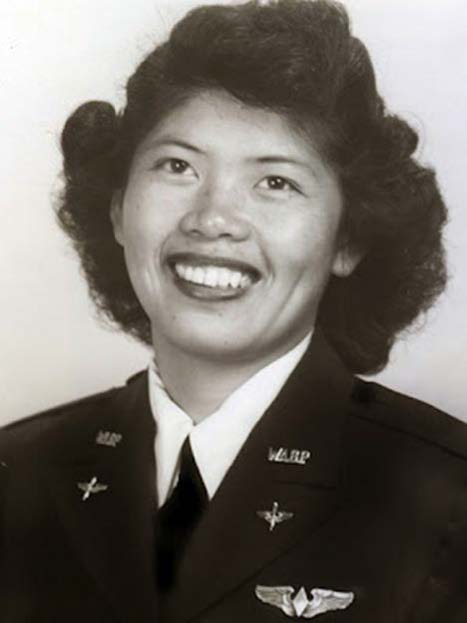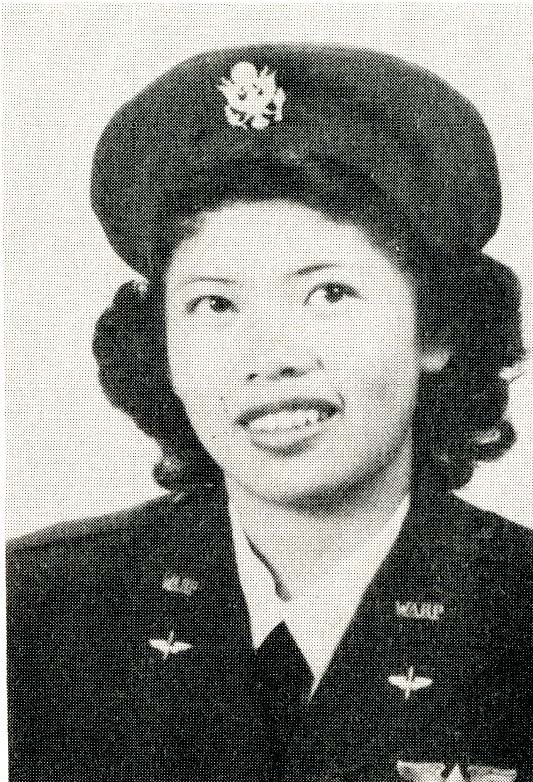The information below has been compiled from a variety of sources. If the reader has access to information that can be documented and that will correct or add to this woman’s biographical information, please contact the Nevada Women’s History Project.

Photo from the Nevada Aerospace Hall of Fame
At a Glance:
Born: August 5, 1923, Berkeley, Calif.
Died: February 1, 2013, Oakland, Calif.
Maiden Name: Gee
Longtime Partner: Warren Heckrotte
Race/nationality/ethnic background: Chinese-American
Primary city and county of residence and work: Minden and Las Vegas, Nev., Berkeley, Calif.
Major fields of work: Pilot, physicist, political activist
Other role identities: WASP
First Nevada woman to serve as WWII military pilot
Margaret “Maggie” Gee was born in Berkeley, California, in August 1923 to second-generation Chinese-American parents. Maggie’s love of airplanes started in childhood when her family took weekend trips to the airport in Oakland, Calif., where Maggie would keep her eye out for her heroine, Amelia Earhart.
After graduating from high school in 1941, Maggie planned to continue her education by studying physics at the University of California, Berkeley, but World War II had begun. Maggie knew she wanted to serve her country. She left college to work at Mare Island Naval Shipyard where her mother was working as a welder. There she took a job assisting engineers in repairing U.S. naval ships. Maggie’s heart, however, did not lie with ships but rather with aircraft. She wanted to pursue her dream of flying and help the war effort. She saved enough money to move to Minden, Nevada, where she took private flying lessons. After earning her pilot’s license within six months, Maggie applied for the Women’s Airforce Service Pilots (WASP) training program.
The WASP program formed when the Women Auxiliary Ferrying Squadron (WAFS) and Women’s Flying Training Detachment (WFTD) merged in 1943. At that time, the Army realized it needed additional pilots to fly domestically so that male pilots could be deployed overseas. While the WASP offered women a rare opportunity to serve, these women were not enlisted into the Army. Rather they were classified as civilians even though they wore the uniform, trained, and followed expectations as if they were a member of the Army Air Force. Initial WASP missions included ferrying planes from factories to the coast where they would be deployed into the theater of war. Later missions included serving as test and drone pilots, instrument and link instructors, administrative pilots, and target towers. The competition to become a WASP was fierce and only 8% of the applicants were accepted into the WASP program.

Image courtesy of the WASP Archive, Texas Woman’s University, Denton, TX
Once accepted into the WASP program, Maggie was ordered to report to Avenger Field in Sweetwater, Texas, for seven months of training. Upon her graduation in Class 44-W-9 on November 8, 1944, Gee earned her silver wings and was assigned to the Las Vegas Army Airfield. During her assignment, Maggie dealt with male pilots who doubted her competence. This stemmed both from being a woman and being of Chinese heritage. Many men felt she and the other WASPs had no place in the service. Maggie carried out her duties which included transporting planes from factories to airbases to prepare them for warfront delivery, instructing male pilots in instrument flying, evaluating pilots who were renewing their instrument ratings, and copiloting B-17 aircraft during gunnery practice using live ammunition.
Gee served in the WASP program until it was disbanded on December 20, 1944. Since WASPs were classified as civilians, they were simply released when they were no longer needed. Having already succeeded in one male-dominated field, it was no surprise to see Gee enter another male-dominated field. Gee returned to the University of California, Berkeley to re-enroll in college to earn both her bachelor’s and master’s degrees in physics. She joined the Army in the 1950s, running service clubs in Germany for four years during the height of the Cold War. Eventually she went to work at Lawrence Livermore National Laboratory. While at the lab, she researched weapon systems in both the nuclear and magnetic fusion programs. It was while working at the lab that she met her longtime partner, Warren Heckrotte, while both were in the same carpool group.
Maggie Gee was also an active community leader and member of the Democratic party, volunteering to run voter registrations and fundraisers. During her life, she served with numerous organizations including the Berkeley Community Fund, the Berkeley Democratic Club, and the Alameda County Democratic Central Committee. Margaret Gee served on the California State Democratic Party Executive Board, the Asian Pacific Islander Democratic Caucus, and the 1992 Democratic Party Platform Committee.
It was not until 1977 with the passage of Public Law 95-202 that Gee and her fellow WASPs earned military status for their wartime service. In 2010, Maggie Gee and the few fellow surviving WASPs were presented a Congressional Gold Medal from President Barack Obama.
Margaret Gee passed away at the age of 89 in 2013. The following year she was enshrined in the Nevada Aerospace Hall of Fame for her role as one of the first women in history to fly American military aircraft in defense of America’s freedom.
Researched and written by Ret. Lt. Col. Anne Davis
Posted July 20, 2022
Sources of information
- “An Interview with Margaret Gee.” Lawrence Livermore National Lab, February 11, 1998. https://www.computer-history.info/Page1.dir/pages/Gee.html (Accessed March 30, 2022).
- Brown, Kimberly. “Maggie Gee, Pioneering Aviator.” California State Library. https://cal170.library.ca.gov/maggie-gee-pioneering-aviator-2/. (Accessed March 30, 2022)
- Hafner, Katie. “Beyond the World War II We Know, Overlooked No More: When Hazel Ying Lee and Maggie Gee Soared the Skies.” New York Times (May 21, 2020; Updated May 26, 2020), https://www.nytimes.com/2020/05/21/obituaries/hazel-ying-lee-and-maggie-gee-overlooked.html Link may require a subscription.
- History of WASP, Women in the Army, https://www.army.mil/women/history/pilots.html (Accessed March 30, 2022).
- “Margaret Gee, 44-W-9 Classbook Photograph.” Women Air Force Service Pilots – Official Archive, Texas Woman’s University. https://twudigital.contentdm.oclc.org/digital/collection/p214coll2/id/4917/rec/26 Accessed March 30, 2022).
- Maggie Gee and the Women Airforce Service Pilots (WASP): Maggie Gee. Las Positas College. https://libraryguides.laspositascollege.edu/MaggieGeeWASP (Accessed March 30, 2022)
- Margaret “Maggie” Gee. The Ninety-Nines Museum of Women Pilots. https://www.museumofwomenpilots.org/women-pilots-margaret-maggie-gee-20.htm (Accessed March 20, 2022).
- National Museum United States Army, Biographies www.thenmusa.org/biographies/margaret-gee/ (Accessed 30 March 2022)
- NWHP Biography Margaret “Maggie” Gee Page 4 of 4
- Nevada Aerospace Hall of Fame, Declaration of Enshrinement, November 8, 2014. http://www.nvahof.org/hof/margaret_gee/ (Accessed February 23, 2022).
- PBA Galleries https://www.pbagalleries.com/content//www/wp-content/uploads/2019/08/Warren-Heckrotte-and-Margaret-Gee.pdf (Accessed March 30, 2022).
- WASP History https://twu.edu/library/womans-collection/collections/women-airforce-service-pilots-official-archive/history/ (Accessed March 30, 2022).

